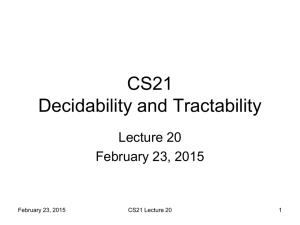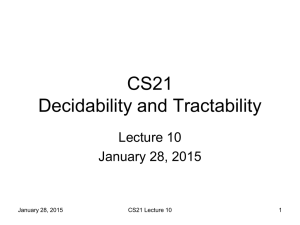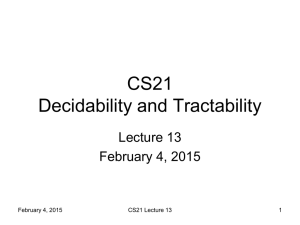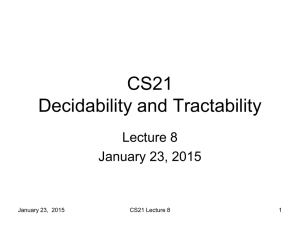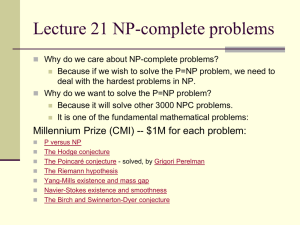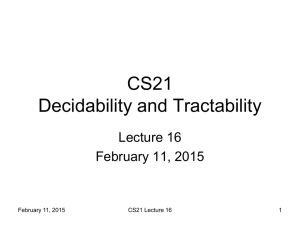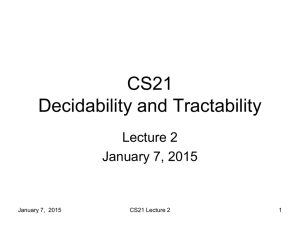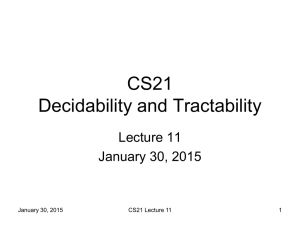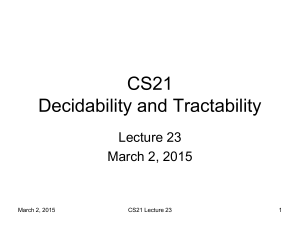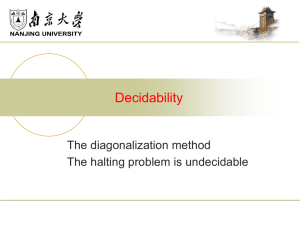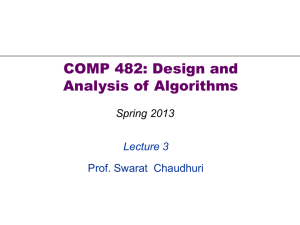CS21 Lecture 1
advertisement
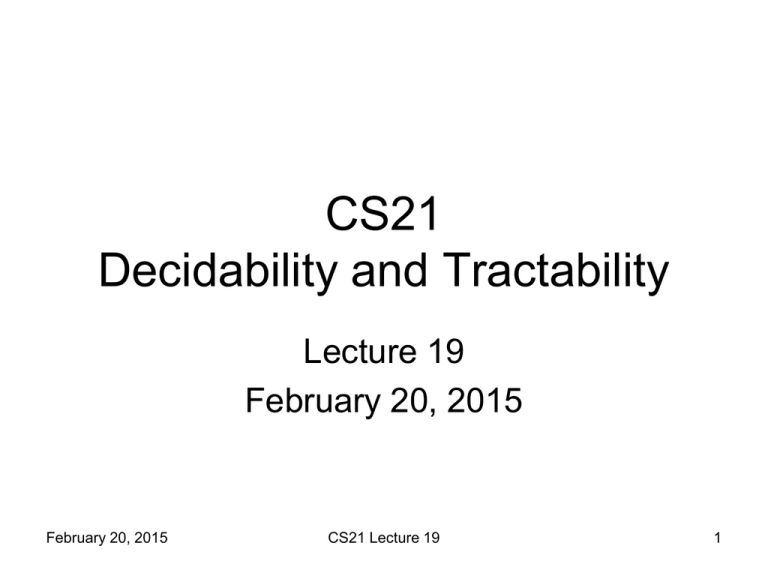
CS21
Decidability and Tractability
Lecture 19
February 20, 2015
February 20, 2015
CS21 Lecture 19
1
Outline
• hardness and completeness
• an EXP-complete problem
• the class NP
– an NP-complete problem
– alternate characterization of NP
– 3-SAT is NP-complete
February 20, 2015
CS21 Lecture 19
2
Hardness and completeness
• Reasonable that can efficiently transform
one problem into another.
• Surprising:
– can often find a special language L so that
every language in a given complexity class
reduces to L!
– powerful tool
February 20, 2015
CS21 Lecture 19
3
Hardness and completeness
• Recall:
– a language L is a set of strings
– a complexity class C is a set of languages
Definition: a language L is C-hard if for
every language A C, A poly-time
reduces to L; i.e., A ≤P L.
meaning: L is at least as “hard” as anything in C
February 20, 2015
CS21 Lecture 19
4
Hardness and completeness
• Recall:
– a language L is a set of strings
– a complexity class C is a set of languages
Definition: a language L is C-complete if L
is C-hard and L C
meaning: L is a “hardest” problem in C
February 20, 2015
CS21 Lecture 19
5
An EXP-complete problem
• Version of ATM with a time bound:
ATMB = {<M, x, m> : M is a TM that
accepts x within at most m steps}
Theorem: ATMB is EXP-complete.
Proof:
– what do we need to show?
February 20, 2015
CS21 Lecture 19
6
An EXP-complete problem
• ATMB = {<M, x, m> : M is a TM that accepts x
within at most m steps}
• Proof that ATMB is EXP-complete:
– Part 1. Need to show ATMB EXP.
• simulate M on x for m steps; accept if simulation
accepts; reject if simulation doesn’t accept.
• running time mO(1).
• n = length of input ≥ log2m
• running time ≤ mk = 2(log m)k ≤ 2(kn)
February 20, 2015
CS21 Lecture 19
7
An EXP-complete problem
• ATMB = {<M, x, m> : M is a TM that accepts x
within at most m steps}
• Proof that ATMB is EXP-complete:
– Part 2. For each language A EXP, need to
give poly-time reduction from A to ATMB.
– for a given language A EXP, we know there
k
n
is a TM MA that decides A in time g(n) ≤ 2
for some k.
– what should reduction f(w) produce?
February 20, 2015
CS21 Lecture 19
8
An EXP-complete problem
• ATMB = {<M, x, m> : M is a TM that accepts x
within at most m steps}
• Proof that ATMB is EXP-complete:
– f(w) = <MA, w, m> where m = 2|w|k
– is f(w) poly-time computable?
• hardcode MA and k…
– YES maps to YES?
• w A <MA, w, m> ATMB
– NO maps to NO?
• w A <MA, w, m> ATMB
February 20, 2015
CS21 Lecture 19
9
An EXP-complete problem
• A C-complete problem is a surrogate for
the entire class C.
• For example: if you can find a poly-time
algorithm for ATMB then there is
automatically a poly-time algorithm for
every problem in EXP (i.e., EXP = P).
• Can you find a poly-time alg for ATMB?
February 20, 2015
CS21 Lecture 19
10
An EXP-complete problem
• Can you find a poly-time alg for ATMB?
• NO! we showed that P ( EXP.
• ATMB is not tractable (intractable).
P
ATMB
decidable
languages
regular
languages
context free
languages
February 20, 2015
CS21 Lecture 19
EXP
11
Back to 3SAT
• Remember 3SAT EXP
3SAT = {formulas in CNF with 3 literals
per clause for which there exists a
satisfying truth assignment}
• It seems hard. Can we show it is
intractable?
– formally, can we show 3SAT is EXPcomplete?
February 20, 2015
CS21 Lecture 19
12
Back to 3SAT
• can we show 3SAT is EXP-complete?
• Don’t know how to. Believed unlikely.
• One reason: there is an important positive
feature of 3SAT that doesn’t seem to hold
for problems in EXP (e.g. ATMB):
3SAT is decidable in polynomial time by
a nondeterministic TM
February 20, 2015
CS21 Lecture 19
13
Nondeterministic TMs
• Recall: nondeterministic TM
• informally, TM with several possible next
configurations at each step
• formally, A NTM is a 7-tuple
(Q, Σ, , δ, q0, qaccept, qreject) where:
– everything is the same as a TM except the
transition function:
δ:Q x → (Q x x {L, R})
February 20, 2015
CS21 Lecture 19
14
Nondeterministic TMs
visualize computation of a NTM M as a tree
Cstart
• nodes are configurations
• leaves are accept/reject
configurations
rej
acc
• M accepts if and only if there exists
an accept leaf
• M is a decider, so no paths go on
forever
• running time is max. path length
February 20, 2015
CS21 Lecture 19
15
The class NP
Definition: TIME(t(n)) = {L : there exists a
TM M that decides L in time O(t(n))}
P = k ≥ 1 TIME(nk)
Definition: NTIME(t(n)) = {L : there exists a
NTM M that decides L in time O(t(n))}
NP = k ≥ 1 NTIME(nk)
February 20, 2015
CS21 Lecture 19
16
NP in relation to P and EXP
decidable
languages
regular
languages
EXP
context free
languages
P
NP
• P NP (poly-time TM is a poly-time NTM)
• NP EXP
– configuration tree of nk-time NTM has ≤ bnk nodes
– can traverse entire tree in O(bnk) time
we do not know if either inclusion is proper
February 20, 2015
CS21 Lecture 19
17
An NP-complete problem
• Version of ATM with a unary time bound,
and NTM instead of TM:
ANTMU = {<M, x, 1m> : M is a NTM that
accepts x within at most m steps}
Theorem: ANTMU is NP-complete.
Proof:
– what do we need to show?
February 20, 2015
CS21 Lecture 19
18
An NP-complete problem
• ANTMU = {<M, x, 1m> : M is a NTM that accepts
x within at most m steps}
• Proof that ANTMU is NP-complete:
– Part 1. Need to show ANTMU NP.
•
•
•
•
simulate NTM M on x for m steps; do what M does
running time mO(1).
n = length of input ≥ m
running time ≤ mk ≤ nk
February 20, 2015
CS21 Lecture 19
19
An NP-complete problem
• ANTMU = {<M, x, 1m> : M is a NTM that accepts
x within at most m steps}
• Proof that ANTMU is NP-complete:
– Part 2. For each language A NP, need to
give poly-time reduction from A to ANTMU.
– for a given language A NP, we know there
is a NTM MA that decides A in time g(n) ≤ nk
for some k.
– what should reduction f(w) produce?
February 20, 2015
CS21 Lecture 19
20
An NP-complete problem
• ANTMU = {<M, x, 1m> : M is a NTM that accepts
x within at most m steps}
• Proof that ANTMU is NP-complete:
– f(w) = <MA, w, 1m> where m = |w|k
– is f(w) poly-time computable?
• hardcode MA and k…
– YES maps to YES?
• w A <MA, w, 1m> ANTMU
– NO maps to NO?
• w A <MA, w, 1m> ANTMU
February 20, 2015
CS21 Lecture 19
21
An NP-complete problem
• If you can find a poly-time algorithm for
ANTMU then there is automatically a polytime algorithm for every problem in NP
(i.e., NP = P).
• No one knows if can find a poly-time alg
for ANTMU…
February 20, 2015
CS21 Lecture 19
22
Poly-time verifiers
• NP = {L : L decided “witness”
by poly-time
NTM}
or
“certificate”
• Very useful alternate definition of
NP:
efficiently
Theorem: language L is in NP if and
only if
verifiable
it is expressible as:
L = { x | 9 y, |y| ≤ |x|k, (x, y) R }
where R is a language in P.
• poly-time TM MR deciding R is a “verifier”
February 20, 2015
CS21 Lecture 19
23
Poly-time verifiers
• Example: 3SAT expressible as
3SAT = {φ : φ is a 3-CNF formula for which
assignment A for which (φ, A) R}
R = {(φ, A) : A is a sat. assign. for φ}
– satisfying assignment A is a “witness” of the
satisfiability of φ (it “certifies” satisfiability of φ)
– R is decidable in poly-time
February 20, 2015
CS21 Lecture 19
24
Poly-time verifiers
L = { x | 9 y, |y| ≤ |x|k, (x, y) R }
Proof: () give poly-time NTM deciding L
phase 1: “guess” y with
|x|k nondeterministic
steps
phase 2:
decide if
(x, y) R
February 20, 2015
CS21 Lecture 19
25
Poly-time verifiers
Proof: () given L NP, describe L as:
L = { x | 9 y, |y| ≤ |x|k, (x, y) R }
– L is decided by NTM M running in time nk
– define the language
R = { (x, y) : y is an accepting computation
history of M on input x}
– check: accepting history has length ≤ |x|k
– check: M accepts x iff y, |y| ≤ |x|k, (x, y) R
February 20, 2015
CS21 Lecture 19
26
Cook-Levin Theorem
• Gateway to proving lots of natural,
important problems NP-complete is:
Theorem (Cook, Levin): 3SAT is NPcomplete.
• Recall: 3SAT = {φ : φ is a CNF formula
with 3 literals per clause for which there
exists a satisfying truth assignment}
February 20, 2015
CS21 Lecture 19
27
Cook-Levin Theorem
• Proof outline
– show CIRCUIT-SAT is NP-complete
CIRCUIT-SAT = {C : C is a Boolean circuit for
which there exists a satisfying truth
assignment}
– show 3SAT is NP-complete (reduce from
CIRCUIT SAT)
February 20, 2015
CS21 Lecture 19
28
Boolean Circuits
• Boolean circuit C
– directed acyclic graph
– nodes: AND (); OR ();
NOT (); variables xi
x1
x2 x3
… xn
• C computes function f:{0,1}n {0,1} in
natural way
– identify C with function f it computes
• size = # nodes
February 20, 2015
CS21 Lecture 19
29
Boolean Circuits
• every function f:{0,1}n {0,1} computable
by a circuit of size at most O(n2n)
– AND of n literals for each x such that f(x) = 1
– OR of up to 2n such terms
February 20, 2015
CS21 Lecture 19
30
CIRCUIT-SAT is NP-complete
Theorem: CIRCUIT-SAT is NP-complete
CIRCUIT-SAT = {C : C is a Boolean circuit for
which there exists a satisfying truth assignment}
Proof:
– Part 1: need to show CIRCUIT-SAT NP.
• can express CIRCUIT-SAT as:
CIRCUIT-SAT = {C : C is a Boolean circuit for
which x such that (C, x) R}
R = {(C, x) : C is a Boolean circuit and C(x) = 1}
February 20, 2015
CS21 Lecture 19
31
CIRCUIT-SAT is NP-complete
CIRCUIT-SAT = {C : C is a Boolean circuit for
which there exists a satisfying truth assignment}
Proof:
– Part 2: for each language A NP, need to
give poly-time reduction from A to CIRCUIT-SAT
– for a given language A NP, we know
A = {x | 9 y, |y| ≤ |x|k, (x, y) R }
and there is a (deterministic) TM MR that
decides R in time g(n) ≤ nc for some c.
February 20, 2015
CS21 Lecture 19
32
CIRCUIT-SAT is NP-complete
• Tableau (configurations written in an
array) for machine MR on input w = (x, y):
w1/qs
w2
w1 w2/q1
w1/q1
a
_/qa
February 20, 2015
_
.
.
.
…
…
…
…
wn
wn
wn
_
…
…
…
…
CS21 Lecture 19
_
_
_
.
.
.
_
• height =
time taken
= |w|c
• width =
space used
≤ |w|c
33
CIRCUIT-SAT is NP-complete
• Important observation: contents of cell in
tableau determined by 3 others above it:
a/q1
b
b/q1
a
a
a
February 20, 2015
b
b
CS21 Lecture 19
b/q1
a
a
a
34
CIRCUIT-SAT is NP-complete
• Can build Boolean circuit STEP
– input (binary encoding of) 3 cells
– output (binary encoding of) 1 cell
a
b/q1
STEP
a
February 20, 2015
a
• each output bit is some
function of inputs
• can build circuit for each
• size is independent of
size of tableau
CS21 Lecture 19
35
CIRCUIT-SAT is NP-complete
Tableau for w1/qs w2
MR on input
w1 w2/q1
w = (x, y)
.
…
…
wn
wn
…
…
.
.
_
_
.
.
.
• |w|c copies of STEP compute row i from i-1
…
STEP STEP STEP STEP
STEP
…
February 20, 2015
CS21 Lecture 19
36
CIRCUIT-SAT is NP-complete
w1
w2
w1/qs
w2
wn
…
wn
…
_
STEP STEP STEP STEP
STEP
STEP STEP STEP STEP
.
.
.
STEP
.
.
.
STEP STEP STEP STEP
STEP
ignore these
1 iff cell contains qaccept
February 20, 2015
CS21 Lecture 19
This circuit
CMR, w has
inputs
w1w2…wn
and C(w) = 1
iff MR accepts
input w.
Size = O(|w|2c)
37
CIRCUIT-SAT is NP-complete
– recall: we are reducing language A:
A = { x | 9 y, |y| ≤ |x|k, (x, y) R }
to CIRCUIT-SAT.
– f(x) produces the following circuit:
x1
x2
…
xn
y1
y2
…
ym
1 iff (x,y) R
– hardwire
input x
– leave y as
variables
Circuit CMR, w
February 20, 2015
CS21 Lecture 19
38
CIRCUIT-SAT is NP-complete
– is f(x) poly-time computable?
• hardcode MR, k and c
• circuit has size O(|w|2c); |w| = |(x,y)| ≤ n + nk
• each component easy to describe efficiently from
description of MR
– YES maps to YES?
• x A 9 y, MR accepts (x, y) f(x) CIRCUIT-SAT
– NO maps to NO?
• x A 8 y, MR rejects (x, y) f(x) CIRCUIT-SAT
February 20, 2015
CS21 Lecture 19
39
